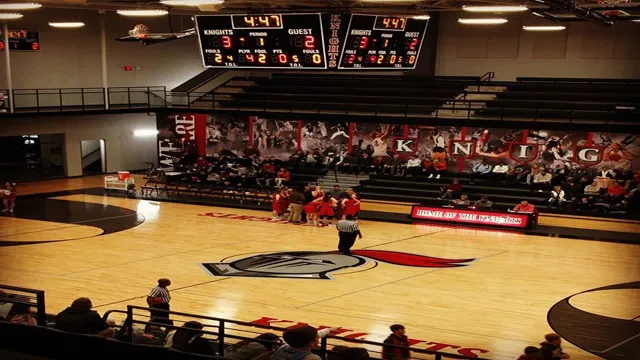Basketball is a sport widely enjoyed and loved by many people. It is an exciting and fast-paced game that requires skill, strategy, and teamwork. In Oklahoma, basketball is no different.
It is a sport that has been played for generations, and its popularity continues to grow. As a result, the Oklahoma Secondary School Activities Association (OSSAA) established guidelines to ensure a fair and competitive environment for all high school basketball teams. Understanding OSSAA basketball classifications is crucial for athletes, coaches, and fans alike.
In this blog, we will delve into the details of these classifications and explore their significance in the Oklahoma high school basketball scene. So, let’s dribble down that court and score some points!
What are OSSAA basketball classifications?
OSSAA basketball classifications refer to the system used by the Oklahoma Secondary School Activities Association (OSSAA) to categorize high school basketball teams by size and enrollment. The classifications are based on the number of students enrolled in each high school, with Class 6A being the largest and Class A being the smallest schools. The teams are then further divided into regions for each classification, with schools within a certain distance from each other competing in the same region.
This allows for balanced competition and gives smaller schools the opportunity to compete against other similarly-sized schools. The OSSAA basketball classifications are reviewed and updated every two years to account for changes in enrollment and ensure fairness for all teams.
Explaining the different levels
OSSAA basketball classifications refer to the different levels of high school basketball competitions in Oklahoma. They are organized by the Oklahoma Secondary School Activities Association (OSSAA) based on school enrollment size, with five classifications from 6A to A. 6A, which includes schools with the largest enrollments, while Class A includes schools with the smallest enrollments.
This system ensures that schools compete against others of similar sizes, leveling the playing field and creating fairer matches. Each classification has its own set of playoffs, with the state championship game being the ultimate goal for all teams. Understanding the different OSSAA basketball classifications is important for players, coaches, and fans alike, as it allows them to better grasp the level of competition that any given team may face.

How teams are placed in classifications
OSSAA basketball classifications are how teams are divided based on school size, location, and performance. The Oklahoma Secondary School Activities Association (OSSAA) establishes these classifications every two years, with the most recent one taking effect in the 2020-2021 season. Schools are placed in classes from 2A to 6A based on their average daily membership (ADM), which is a calculation of the school’s student population over the past three years.
The higher the ADM, the higher the classification. This process ensures that schools of similar size and competitive ability play against each other, providing fair and balanced matchups. Additionally, schools may also be moved up or down in classification based on recent performance or location changes.
The OSSAA works to provide equal opportunities for all schools, and the classification system is one way they achieve that goal.
Classifications and Competitive Balance
The OSSAA basketball classifications play a crucial role in determining the competitive balance of high school basketball in Oklahoma. The classifications are based on the number of students enrolled in each school and range from Class A to Class 6A. This means that a school with a larger student population will play against other schools of similar size, while smaller schools will compete against similarly sized schools.
The intent behind this system is to create fair and balanced competition for all schools, regardless of their size. By having schools of similar sizes compete against each other, it ensures that smaller schools are not overwhelmed by larger schools and gives them a chance to be competitive. Ultimately, the OSSAA basketball classifications provide a level playing field for all high school basketball teams in the state and help to create an exciting and competitive atmosphere for players and fans alike.
Why classifications matter for competitiveness
Competitive Balance In the world of sports, competitive balance is crucial for the success and growth of the industry. To achieve this balance, sports leagues often create classifications based on team performance, financial resources, or geographical location. These classifications aim to ensure that every team has a fair chance to compete against others and maintain the interest of fans.
If one team dominates for too long, fans may lose interest in the sport and the industry could suffer. On the other hand, having a more balanced and competitive league can attract new fans and increase revenue streams. Therefore, classifications are essential for ensuring a fair and level playing field, which is key to creating a sustainable and successful sports industry.
Examining the success rate of different classifications
When it comes to examining the success rate of different classifications in sports, there’s an important factor that needs to be considered: competitive balance. In essence, this refers to how evenly matched teams are in a given league or competition. When there’s high competitive balance, it means that any team has a chance to win on any given day.
On the other hand, when there’s low competitive balance, it can lead to a predictable outcome where the same few teams always come out on top. This is why different classifications are often used in sports, such as dividing teams into different divisions or having different weight classes in combat sports. By doing so, it helps to promote competitive balance and gives more teams or athletes a chance to succeed.
So the next time you’re watching a game or a match, remember that classifications play a crucial role in determining the overall success rate.
How teams can move up or down in classifications
Competitive balance A team’s performance in any sport determines its classification, which determines who they play against in the future. Teams that do well in their current classification are moved up to a higher classification to face tougher competition. Conversely, teams that struggle in their classification can be relegated to a lower classification where the level of competition is not as daunting.
Competitive balance is the main aim of this classification system, which promotes more exhilarating games as teams compete against their equals. While moving up or down may be challenging, it is essential for teams to maintain their performance, work hard, and stay motivated to compete at the highest level. This also brings a sense of excitement to the players and fans, anticipating a new level of competition and experience.
Ultimately, competitive balance in any sport is what makes it more compelling and engaging for everyone involved.
Impacts on Players and Communities
The OSSAA’s decision to change basketball classifications has had a significant impact on players and communities throughout Oklahoma. While some teams have been placed in more competitive divisions, others have moved down, giving them a chance to compete at a higher level. This change has led to some teams struggling to adapt to the new competition, while others have thrived under the new rules.
Additionally, the shift in classifications has affected travel requirements and schedules for many teams, particularly those in rural areas. This can put a strain on both players and families, as they adjust to the changes and find ways to accommodate the added demands of the sport. Despite these challenges, many see the new classification system as a positive change, one that has the potential to create a more level playing field and give more student-athletes the chance to shine on the court.
In the end, the OSSAA’s decision will have a lasting impact on Oklahoma basketball and the players and communities that support it.
How classifications affect player experiences and opportunities
Classifications have a significant impact on the experiences and opportunities available to players and communities. Whether it’s in the world of gaming or sports, the way that players are classified and categorized can affect everything from how they are perceived by others to the types of opportunities that are available to them. For example, in the gaming world, classifications can determine the types of games that players are able to access, as well as the types of gaming communities that they can be a part of.
If a player is classified as a casual gamer, for instance, they may be excluded from more serious and competitive gaming communities, which limits their opportunities to improve their skills and compete at a higher level. Similarly, in the world of sports, classifications can determine the types of leagues and teams that players are able to join. If a player is classified as a beginner, for example, they may be limited to playing in recreational leagues, which can be frustrating for those who are looking to play at a more competitive level.
Ultimately, the way that players are classified can have a profound impact on their experiences and opportunities in their respective communities. It’s important, therefore, that these classifications are fair, accurate, and inclusive, so that all players are given the chance to achieve their full potential and enjoy the games and sports that they love.
Community pride and support for different classifications
Community pride and support can have a significant impact on players as well as the communities they belong to, especially when it comes to different classifications in sports. When a community collectively rallies behind their team, players can feel a sense of pride and motivation to perform better. On the other hand, players may feel discouraged and unsupported when their community does not show them the same level of enthusiasm.
This can lead to a loss of confidence and less motivation to give their all on the field. Additionally, when communities embrace players of different classifications, it can help break down barriers and stereotypes, leading to a more inclusive and diverse environment. This can benefit players by helping them feel a sense of belonging and acceptance, while also strengthening the overall community through unity and diversity.
Overall, community support and pride can have a powerful influence on players, and it is important to recognize and embrace the different classifications that make up our sports communities.
Final Thoughts and Future Changes
In conclusion, the OSSAA basketball classifications have been a hot topic for many fans and players alike. There have been some criticisms and suggestions for changes to the current system, such as reevaluating the criteria for school size and possibly adding a fifth classification. With the upcoming season just around the corner, it will be interesting to see if any changes are made or if the current system will remain in place.
Overall, the OSSAA and basketball community will continue to work towards improving the fairness and competitiveness of the sport.
Conclusion
In the world of Ossaa basketball classifications, it’s not just about the size of the school, it’s about the size of the heart and the determination of the players. Whether you’re in Class 2A or 6A, the game is all about giving it your all and leaving everything on the court. So, let’s tip off and show the world what true passion for basketball looks like!”
FAQs
What are the different OSSAA basketball classifications?
The OSSAA basketball classifications range from Class A to Class 6A, with each class determined by school enrollment numbers.
How does a school’s enrollment affect their OSSAA basketball classification?
A school’s enrollment numbers determine which OSSAA basketball classification they are placed in, with larger schools being placed in higher classifications.
Do smaller schools have an advantage in lower OSSAA basketball classifications?
Smaller schools may have an advantage in lower OSSAA basketball classifications due to a smaller pool of talent and more individualized coaching.
How are the OSSAA basketball classifications determined for private schools?
Private schools are assigned to OSSAA basketball classifications based on a formula that considers student enrollment, tuition rates, and the number of students receiving financial aid.
Can schools appeal their OSSAA basketball classification placement?
Yes, schools have the right to appeal their OSSAA basketball classification placement, but the appeal must be based on valid reasons such as inaccurate enrollment counts or geographic location.


